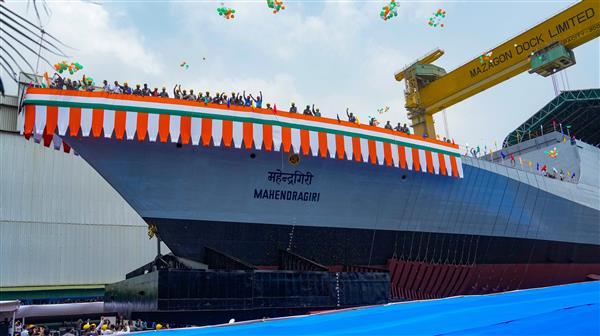Indian Navy’s stealth frigate Mahendragiri launched
Context
Sudesh Dhankhar, the wife of Vice-President Jagdeep Dhankhar, launched Mahendragiri, the seventh and last stealth frigate of Project 17A, on Friday at Mazagon Dock Shipbuilders Ltd. (MDL) in Mumbai.
What is Project 17-A?
- Stealth guided-missile frigates are being constructed for the Indian Navy as part of Project 17A (P-17A). The ships, which are a successor class to the Project 17 (Shivalik Class) frigates, have enhanced stealth capabilities, cutting-edge weapons and sensors, and platform management systems. The Nilgiri was launched as the first stealth ship in 2019.
- The ships were created in-house by the Warship Design Bureau of the Indian Navy. The ships are being constructed by Mazagon Dock Shipbuilders (MDL) and Garden Reach Shipbuilders & Engineers (GRSE).
- On September 1, 2023, Mahendragiri, the seventh and last ship of the Project 17A frigates, was launched. The vessel is 17.8 meters broad and 149 meters long. It is anticipated to be put into service in 2024.
What are Frigate class ships?
A frigate is a class of naval warships that, in terms of size, capabilities, and function, sits between a destroyer and a corvette. In addition to escorting larger ships, patrolling territorial waters, engaging in anti-submarine warfare, and engaging in air and surface combat, frigates are multipurpose ships.
What are the characteristics?
- Size: The normal size of a frigate is that of a medium-sized warship, bigger than a corvette but smaller than a destroyer.
- Armament: They are armed with a variety of weapons, including torpedoes, naval guns, electronic warfare systems, and anti-ship and anti-aircraft missiles. Due to their adaptability, frigates can combat various threats.
- Sensors and Systems: Frigates are outfitted with sophisticated radar, sonar, and sensor systems that allow them to find and follow aircraft, surface ships, and submarines.
- Multi-Mission Capability: Frigates are versatile assets for naval operations since they are built to perform a variety of tasks. They are capable of air defence, surface, and anti-submarine warfare.
- Speed and Endurance: Frigates can operate independently or as a member of a naval task force and are designed for long-term operations at sea. They have the speed and stamina required for lengthy deployments.
- Protection: These ships frequently have armour to safeguard critical systems, close-in weapon systems (CIWS) for protection against incoming threats, and countermeasures against missiles.
How does this showcase the capabilities of Indian industries?
- President Murmu highlighted this occasion as a significant step toward the Atmanirbhar Bharat (Self-Reliant India) vision.
- Local shipbuilding is thought to be a key factor in reducing dependency on imports and advancing the country’s technological prowess.
- An illustration of India’s commitment to technological advancement in the maritime and defence sectors is Project 17A.
- To increase local capabilities and reduce reliance on outside sources, the initiative is a crucial step.
Which are the other Naval ships under this series?
The P-17A frigates were given their name in honour of the old Nilgiri-class frigates, which were used by the IN from 1972 to 2013. The names used by the earlier class were given to the first six ships in the series: Nilgiri, Himgiri, Taragiri, Udaygiri, Dunagiri, and Vindhyagiri. Without a namesake from the earlier class, Mahendragiri became the replacement name for the seventh and last P-17A series ship.
What are the benefits of launching the final frigate in the series?
- Enhanced Naval Capabilities: With the addition of Mahendragiri to the fleet, India’s military now has two cutting-edge stealth frigates. This improves the Indian Navy’s total naval capability because these frigates are outfitted with cutting-edge equipment and weapons for a variety of maritime operations.
- Enhanced Maritime Security: With Mahendragiri on board, India is now better equipped to patrol and protect its maritime borders and interests. It helps defend the country’s economic and security interests by assisting in the safeguarding of India’s Exclusive Economic Zone (EEZ) and marine trade routes.
- Dissuasion: The presence of contemporary frigates like Mahendragiri can dissuade potential enemies. It makes it quite evident that India is capable of protecting its maritime interests and successfully addressing any security challenges.
- Operational Flexibility: The Indian Navy can use Mahendragiri and other frigates of a similar design for a variety of activities, including HADR (humanitarian assistance and disaster relief) operations, anti-submarine warfare, anti-surface warfare, and anti-air operations. Responding to varied maritime concerns requires adaptability.
- Regional Influence: An adequately stocked navy with contemporary frigates can increase India’s influence in the greater Indo-Pacific region as well as the Indian Ocean region. This may be crucial for diplomatic and strategic interactions with regional allies and neighbours.





